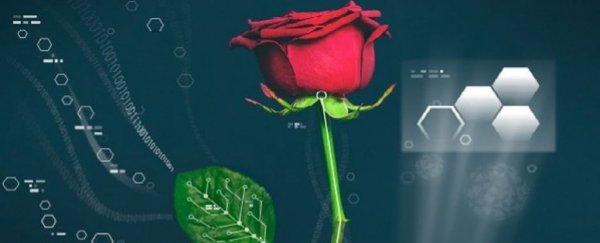For the first time, scientists have created analogue and digital electronic circuits inside living plants, using the vascular system of living roses to build – or rather 'grow' – the central components of electronic circuits.
Researchers at Linköping University in Sweden merged numerous electrical components inside the roses, including wires, digital logic, and even display-based elements, thanks to a special polymer that's capable of acting like a wire while still transporting organic material such as water and nutrients through the rose's stem.
By successfully incorporating electronics into the living systems of plants, it's hoped we'll be able to find out much more about the chemical processes and pathways that make them function – and we could even learn to control and manipulate them.
"Previously, we had no good tools for measuring the concentration of various molecules in living plants," said one of the team, biologist Ove Nilsson. "Now we'll be able to influence the concentration of the various substances in the plant that regulate growth and development."
The polymer that makes this possible is called PEDOT-S. It was one of many materials trialled by the researchers but was the only synthesised substance that successfully assembled itself inside the rose's xylem channels, which transport water and nutrients upwards from the root.
Passing through the channels as a hydrogel, PEDOT-S formed into conducting wires up to 10 centimetres in length and, in doing so, didn't impede the passage of vital chemicals keeping the plant alive. The researchers managed to combine the polymer with electrolytes that surround the xylem channels, effectively creating an electrochemical transistor that converts ionic signals to electronic output.
By infusing another variant of the PEDOT polymer into the roses, the researchers created a kind of organic pixel display in the plant's leaves by partitioning certain electrochemical cells. When voltage was applied, the polymer interacted with the ions in the leaf and changed its colour.
The researchers describe these initial forays into plant electronics as early steps but believe they could help pave the way for a new field of research that fuses plant science and organic electronics. Potential applications down the track could include things like photosynthesis-based fuel cells, sensors and growth regulators, or tools that control the internal processes of plants.
"As far as we know, there are no previously published research results regarding electronics produced in plants. No one's done this before," said Magnus Berggren, who led the research, which has been published in Science Advances. "Now we can really start talking about 'power plants' – we can place sensors in plants and use the energy formed in the chlorophyll, produce green antennas, or produce new materials. Everything occurs naturally, and we use the plants' own very advanced, unique systems."
With the researchers are expecting their discovery to potentially impact everything from energy sources to environmental sustainability, we can't wait to see where plant electronics leads.
